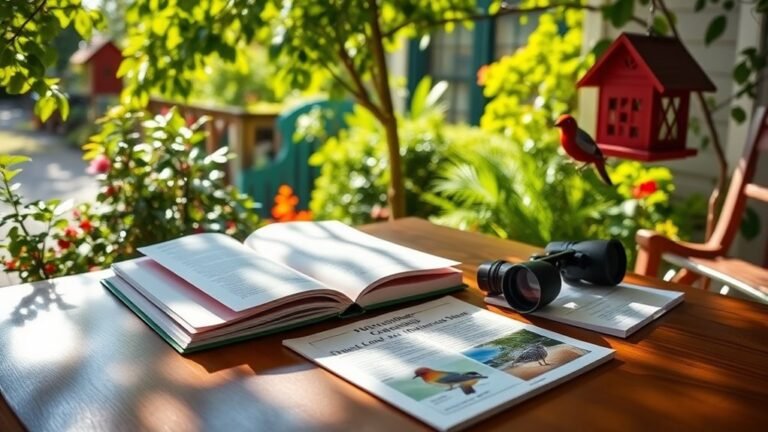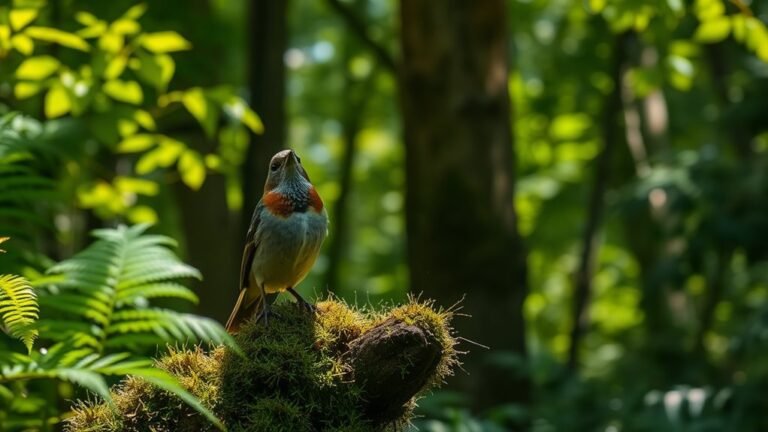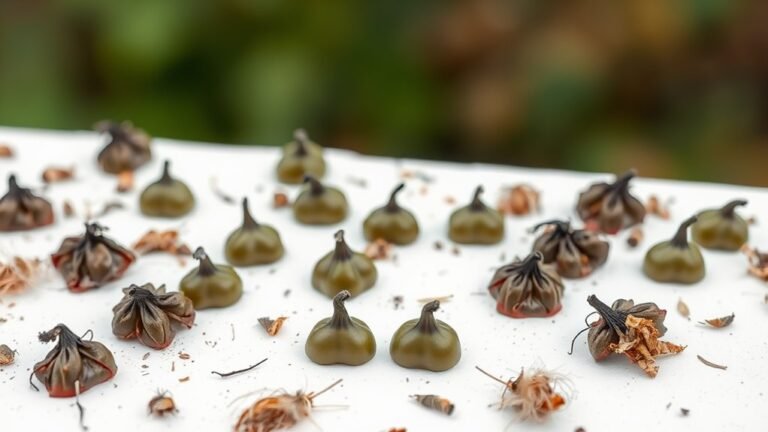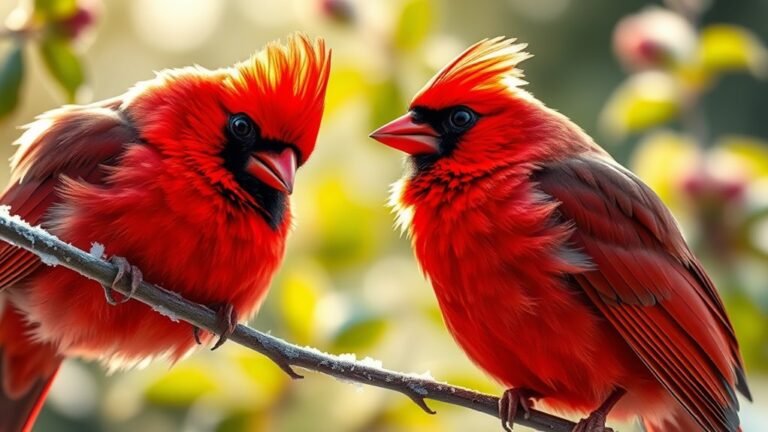How Far Apart Should Multiple Nest Boxes Be Placed?
When placing multiple nest boxes, consider the needs of different bird species. The distance between boxes can affect their nesting success and behavior. Some birds prefer boxes close together, while others need more space. Here are some important factors to keep in mind when deciding how far apart to place your nest boxes:
- Species Requirements: Research the specific spacing needs for the bird species you want to attract.
- Territorial Behavior: Some birds are territorial and may not tolerate other birds nearby.
- Environmental Conditions: Take into account the surroundings, such as vegetation and available food sources.
- Predation Risk: Greater spacing can reduce the risk of predation for nesting birds.
By considering these factors, you can create a suitable environment that encourages successful nesting for various bird species.
Key Takeaways
Cavity-nesting birds, like bluebirds and chickadees, should have nest boxes spaced 100 to 300 feet apart. This distance helps reduce competition for resources. Wrens can have nest boxes closer together, with a spacing of 30 to 50 feet. Larger birds, such as owls, need at least 500 feet between their nest boxes.
To minimize conflicts and stress among birds, space all nest boxes at least 15 to 20 feet apart. Keep in mind seasonal habits and local habitat changes when deciding the best placement and timing for the boxes. This will help create a comfortable environment for the birds.
Understanding Bird Territoriality
Understanding bird territoriality is important for placing nest boxes because the distance between them affects nesting success. Birds have specific territorial behaviors that shape their nesting choices. Species with strong territorial instincts need more space between boxes to prevent conflicts. If boxes are too close, the birds may become stressed and avoid nesting.
Observing the bird species in your area can help you understand their territorial needs. Some birds prefer solitude, while others may accept close proximity if they've established territories.
Factors Influencing Nest Box Spacing
When spacing your nest boxes, consider some important factors that can affect the success of nesting birds.
First, the design of the nest box matters. Features like the size of the entrance and ventilation can attract specific bird species.
Different birds prefer different distances between their nesting sites, influenced by their territorial behavior.
The type of habitat around your nest boxes also impacts spacing. In areas with dense foliage, you can place boxes closer together, while in open spaces, you'll need to keep them farther apart.
Recommended Distances for Common Bird Species
To attract different bird species, place nest boxes at the right distances.
For cavity-nesting birds like bluebirds and chickadees, space the boxes 100 to 300 feet apart. This distance helps reduce competition and stress.
Wrens, however, prefer boxes closer together, about 30 to 50 feet apart, as they tolerate neighbors better.
For larger birds like owls, place their boxes at least 500 feet apart to prevent territorial disputes.
Knowing these distances creates a safe and welcoming environment for birds to nest in your garden or backyard.
The Role of Habitat Type in Nest Box Placement
The placement of nest boxes is important for attracting birds, and habitat type plays a key role. Different bird species prefer different environments. Some birds like dense foliage for nesting, while others prefer open areas.
By observing the local plants and habitat, you can place nest boxes in locations that meet the needs of various birds. For example, placing boxes near thick shrubs can help birds that need cover, while boxes in open spaces may attract other species.
Attracting Multiple Species: Best Practices
Placing nest boxes in strategic locations can attract various bird species, which boosts local biodiversity.
To improve your chances of success, choose different nest box designs that meet the specific needs of each species, including size, entrance hole diameter, and materials.
Position the boxes at different heights and locations, such as near water sources or gardens, to appeal to a range of birds.
Include flowering plants nearby to attract pollinators, creating a welcoming habitat for both birds and beneficial insects.
Keep a respectful distance between boxes to allow birds to nest comfortably without feeling threatened.
Avoiding Competition and Aggression Among Birds
To support bird biodiversity, provide a range of nest boxes while minimizing competition and aggression. Space the nest boxes at least 15 to 20 feet apart. This distance helps each bird species feel safe in its own area.
Pay attention to the territorial behaviors of the birds you want to attract, as some may be more aggressive than others. Understanding these behaviors helps create a peaceful environment.
Additionally, vary the height and type of nest boxes to suit different species. This variety can reduce conflicts among birds.
Thoughtful placement of the boxes encourages a sense of belonging for your feathered friends, promoting harmony in your backyard.
Seasonal Considerations for Nest Box Placement
Understanding the seasonal habits of birds can greatly improve your nest box placement. Different bird species migrate at different times, so it's essential to consider their nesting patterns. Position your boxes where they'll be ready when birds return in spring.
Avoid placing boxes too close together, as some species prefer privacy during breeding.
Also, consider how local habitats change with the seasons. For example, thick leaves in summer provide shelter, while bare branches in winter may expose boxes to harsh weather.
Monitoring Nest Box Usage and Adjusting Placement
To ensure your nest boxes are effective, regularly check their usage. Observe which boxes birds occupy and how often. This helps you see usage patterns that can guide future placements.
Pay attention to any boxes that stay empty; they might be too close to others or in less favorable spots. Adjusting the spacing based on these observations can create a more inviting environment for birds.
Also, note the different bird species visiting each box. This information can help you optimize placements for various types of birds.
Enhancing Nest Box Appeal With Surrounding Environment
Creating an inviting environment around your nest boxes can attract more birds. Here are some simple strategies to enhance their appeal:
- Diverse Plant Life: Plant native species that provide food and shelter for birds.
- Water Sources: Add birdbaths or small ponds to encourage visits from birds.
- Natural Cover: Include shrubs or brush piles to offer nesting sites and protection.
These changes not only beautify your space but also support local wildlife.
A rich environment around your nest boxes helps birds feel safe and encourages them to settle in, making your backyard a lively habitat for all.
Local Regulations and Guidelines for Nest Box Installation
Before installing nest boxes, check local regulations and guidelines. Some areas require permits for setting up structures like nest boxes.
Contact your local wildlife agency or municipality to ensure you follow the rules. Guidelines may specify where to place the boxes, how high to install them, and the distance between each box.
Following these rules supports local ecosystems and shows responsibility among nature enthusiasts. By complying with regulations, you respect the environment and contribute positively to your community.
Your project can help improve biodiversity while fitting well into your area's framework.
Frequently Asked Questions
How Can I Tell if Birds Are Avoiding My Nest Boxes?
To find out if birds are avoiding your nest boxes, watch their behavior closely. Look for fewer visits or a lack of interest in the boxes. If you see birds acting distressed or hesitant, they may not feel safe or comfortable with the setup. Make adjustments to the nest boxes to encourage more activity.
What Materials Are Best for Constructing Nest Boxes?
When building nest boxes, use durable wood like cedar or pine for the main structure. These materials provide strength and longevity. Consider adding insulation, such as foam, to help maintain a stable temperature inside the box. This creates a cozy environment that encourages birds to settle and thrive.
Can Nest Box Placement Affect Bird Breeding Success?
Yes, nest box placement can significantly influence bird breeding success. Properly placing boxes respects the breeding territory of birds. This encourages healthy nesting behavior. By considering these factors, you increase the chances of successful breeding and improve community involvement.
How Do I Clean and Maintain Multiple Nest Boxes?
To keep your nest boxes in good condition, clean them after each season. Use warm, soapy water and a scrub brush. Regularly check for any damage and ensure proper drainage. This will help keep birds safe and comfortable.
Should I Mark My Nest Boxes for Identification Purposes?
Yes, mark your nest boxes for identification. Use clear methods like color-coding or numbering. This practice helps you track occupancy and maintenance. Each box will function effectively in your habitat.

Ava is a bird enthusiast and nature lover who has spent countless hours observing and learning about the fascinating world of birds. With a passion for sharing her knowledge and inspiring others to appreciate the beauty of birds, Ava writes about her experiences and insights on avianadmirer.com.







